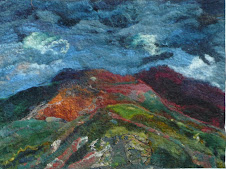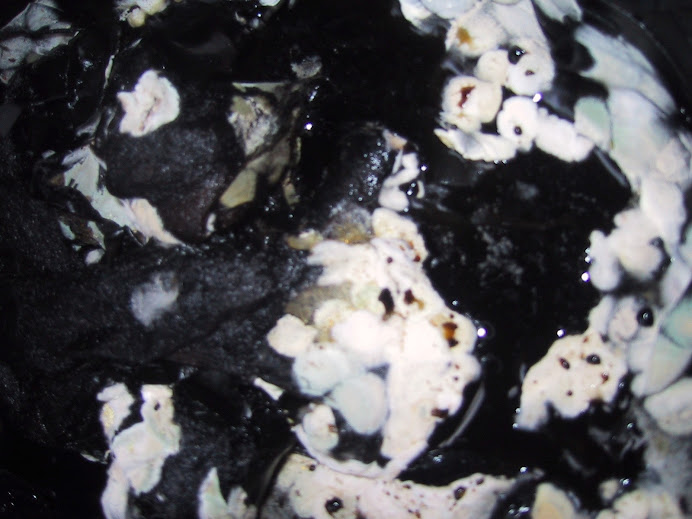
Both the DS's have gone back to normal life one to job and v.busy social life, and the other to finish his PH.D. DH has gone off to work so as soon as I could I went to investigate the "inks" I had made before Christmas. I had put a tablespoon of dye chips, except for the saffron which was 1g , added 100ml of water and put them into jam jars in the slow cooker which were making dyebaths for 48 hours or so. Then I filtered them through coffee filter papers into glass spice jars and left them till today.
Left Column top to bottom. Saffron, Cutch, Walnut with iron added, logwood with iron added ( surprising! and I have now added some washing soda to get purple).
Right Column. Cochineal with tin added after filtering & ammonia. Cochineal with iron & ammonia, Black oak -disappointing as an "ink" ,Cochineal with tin added at the soaking stage.
You can see from these samples how watery and runny the " inks/paints" ( I am not sure what to call them!) are so I thought that I would try and see what "stabalising" with gum arabic means. ( see previous post)
I hunted out some old dusty gum arabic and tried to find a reference in my dye books to using it. I am sure Liles has it in but could I find my Liles? Could I heck. In the process I found I have no less than two copies of Bemiss! Who is not a lot of use in this case. Nor were my other dye books although I must confess my search was a bit cursory. There was nothing in Cardon, nor in Jenny Dean's, nor in Susan Bosence books for example although I am sure I have seen a recipe somewhere.
I tried dissolving a few lumps of gum arabic in water in my studio microwave , but in the end heated them, stirring in a small pan till no more would dissolve and then added the resulting solution to my "inks". It did not make much difference and in the end I added in the order of 1 tablespoon of gum arabic solution to 50ml of " ink". I was planning to go back after I had eaten but succumbed to the temptation of watching The Titanic sink on BBC2-why I cannot think as it is a lousy film apart form the sinking bit which is quite dramatic so I put it down to being still post bug as as my legs still feel a bit jelly like it will have to do as an a excuse. So I will have to wait till tommorow to see whether I think there is any improvement . I have painted with dye thickened with gum tragacanth which makes a sort of textured paint so it will be interesting to see the difference between the different types of thickener.



























If this doesn't spoil the arrival of your new book by Ralph Mayer, his advice is that you pour boiling water onto the gum arabic, and if it doesn't dissolve, leave it for a few hours, as heating further can change the properties of the gum.
ReplyDeleteI'm amazed that I knew so little about natural colours / dyes before recently, and now I find they are so useful. How could I get A level in Art and not know where colour came from, and how paints, inks, dyes are made?
I'm following your work with great interest, especially since when I was working with watercolours a couple of years ago it was clear to me that the colours I liked were the natural earth pigments.
Ah! I should have waited for the book! I just was so keen to have a play I jumped in! I am really looking forward to the book which the very nice elderly couple who are selling it to me said thay had posted yesterday morning so I have no excuse.
ReplyDeleteWhen I started natural dyeing I had no idea that I was walking through a door to such a wonderful world! I also used to think that I knew quite a lot , now the more I learn the more I realise there is to learn.
I have got a set of earth pigments I bought at Colour Congress The technique I learnt there was binding them with soya milk to paint fabrics with but I have never done it as I have been too busy on felt. However I can see that they may coming in useful soon
there are several interesting links in german available about inks, but usually the recipes are given from about 1800 +.... there are also some useful hints and tips in the "schweppe", a german book about natural dyes, pigments and inks - very chemical in parts, but one of the most complete books I've come across. unfortunately not available translated, but if you were looking for special stuff I could always look for it and translate the part....
ReplyDeleteget better soon! and thanks for the tip with the pads, I'll have a lookout for those!
Hi Bettina, I will read my new books, the ones Dorothy recommended and follow up one or two leads in The Colourful Past, by Judith h. Hofenk de Graff who mentions two 16th century treatises on inks but I would welcome any input -just don't want to put you to too much trouble ( oh! that is a a very English statement :). Rephrasing it - Yes I would love to get something from your book thanks.
ReplyDelete